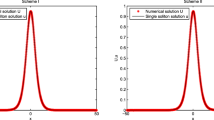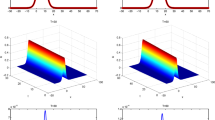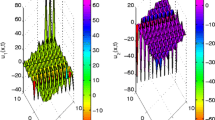Abstract
In this article, the Kawahara and modified Kawahara equations with dual-power law nonlinearities are solved based on the sine-cosine method and finite difference schemes. The fourth-order accurate difference scheme for the Kawahara equation and the second-order accurate difference scheme for the modified Kawahara equation have been constructed. The difference schemes have energy conservative properties. The existence, uniqueness, stability, and convergence of the numerical solutions are all well established. Finally, some numerical experiments demonstrate the reliability of the theoretical statements. Also, comparisons between the solutions obtained from the exact solitary wave solutions and the linearly finite difference schemes are made to demonstrate that the present schemes are efficient and reliable, and can simulate the single or multi-solitary waves propagating at a long period.











Similar content being viewed by others
Data availability
No data was used for the research described in the article.
References
Darvishi, M.T., Khani, F.: Numerical and explicit solutions of the fifth-order Korteweg-de Vries equations. Chaos Soliton. Fract. 39, 2484–2490 (2009)
Goswami, A., Singh, J., Kumar, D.: Numerical simulation of fifth-order KdV equations occurring in magneto-acoustic waves. Ain Shams Eng. J. 9, 2265–2273 (2018)
Mei, L.Q., Chen, Y.P.: Numerical solutions of RLW equation using Galerkin method with extrapolation techniques. Comput. Phys. Commun. 183, 1609–1616 (2012)
Korteweg, D.J., de Vries, G.: On the change of form of long waves advancing in a rectangular canal, and on a new type of long stationary waves. Philos. Mag. 39, 422–443 (1895)
Wazwaz, A.M.: The extended tanh method for new solitons solutions for many forms of the fifth-order KdV equations. Appl. Math. Comput. 184, 1002–1014 (2007)
Lee, C.T.: Some remarks on the fifth-order KdV equations. J. Math. Anal. Appl. 425, 281–294 (2015)
Ismail, H.N.A., Raslan, K.R., Salem, G.S.E.: Solitary wave solutions for the general KdV equation by Adomian decomposition method. Appl. Math. Comput. 154, 17–29 (2004)
Bona, J.L., Dougalis, V.A., Karakashian, O.A., et al.: Conservative, high-order numerical schemes for the generalized Korteweg-de Vries equation. Philos. Trans. Royal Soc. London Ser. A 351, 107–164 (1995)
Başhan, A.: Bell-shaped soliton solutions and traveling wave solutions of the fifth-order nonlinear modified Kawahara equation. Int. J. Nonlin. Sci. Num. 22, 781–795 (2021)
Wazwaz, A.M.: Compactons and solitary patterns solutions to fifth-order KdV-like equations. Phys. A 371, 273–279 (2006)
Salas, A.H.: Exact solutions for the general fifth KdV equation by the exp function method. Appl. Math. Comput. 205, 291–297 (2008)
Saba, F., Jabeen, S., Akbar, H., et al.: Modified alternative (G’/G)-expansion method to general Sawada-Kotera equation of fifth-order. J. Egypt. Math. Soc. 23, 416–423 (2015)
Lax, P.D.: Integrals of nonlinear equations of evolution and solitary waves. Comm. Pure Appl. Math. 62, 467–490 (1968)
Wazwaz, A.M.: Multiple complex soliton solutions for the integrable KdV, fifth order Lax, modified KdV, Burgers, and Sharma-Tasso-Olver equations, Chinese. J. Phys. 59, 372–378 (2019)
Jiang, X.H.: Asymptotic analysis of a perturbed periodic solution for KdV equation. Stud. Appl. Math. 116, 21–33 (2006)
Ito, M.: An extension of nonlinear evolution equations of the KdV (mKdV) type to higher orders. J. Phys. Soc. Jpn. 49, 771–778 (1980)
Wazwaz, A.M.: Solitons and periodic solutions for the fifth-order KdV equation. Appl. Math. Lett. 19, 1162–1167 (2006)
Al-Mdallal, Q.M., Syam, M.I.: Sine-cosine method for finding the soliton solutions of the generalized fifth-order nonlinear equation. Chaos Soliton. Fract. 33, 1610–1617 (2007)
Wongsaijai, B., Poochinapan, K.: A three-level average implicit finite difference scheme to solve equation obtained by coupling the Rosenau-KdV equation and the Rosenau-RLW equation. Appl. Math. Comput. 245, 289–304 (2014)
Sukantamala, N., Nanta, S.: On solitary wave solutions for the Camassa-Holm and the Rosenau-RLW-Kawahara equations with the dual-power law nonlinearities. Abstract and Applied Analysis (2021). https://doi.org/10.1155/2021/6649285
Mia, A.S., Akter, T.: Some exact solutions of two fifth-order KdV-type nonlinear partial differential equations. J. Partial Differ. Eqs. 25, 357–67 (2012)
Wazwaz, A.M.: Multiple-soliton solutions for the fifth order Caudrey-Dodd-Gibbon (CDG) equation. Appl. Math. Comput. 197, 719–724 (2008)
Kaya, D.: An explicit and numerical solutions of some fifth-order KdV equation by decomposition method. Appl. Math. Comput. 144, 353–363 (2003)
Polat, N., Kaya, D., Tutalar, H.I.: A analytic and numerical solution to a modified Kawahara equation and a convergence analysis of the method. Appl. Math. Comput. 179, 466–472 (2006)
Yuan, J.-M., Shen, J., Wu, J.: A dual-Petrov-Galerkin method for the Kawahara-type equations. J. Sci. Comput. 34, 48–63 (2008)
Khanal, N., Sharma, R., Wu, J., et al.: A dual-Petrov-Galerkin method for extended fifth-order Korteweg-de Vries type equations, Discrete Contin. Dyn. Syst. (2009) pp. 442–450
Yuan, J.-M., Wu, J.: A dual-Petrov-Galerkin method for two integrable fifth-order KdV type equations. Discrete Contin. Dyn. Syst. 26, 1525–1536 (2010)
Ablowitz, M., Segur, H.: On the evolution of packets of water waves. J. Fluid Mech. 92, 691–715 (1979)
Ali, A., Kalisch, H.: On the formulation of mass, momentum and energy conservation in the KdV equation. Acta Appl. Math. 133, 113–131 (2014)
Nanta, S., Yimnet, S., Poochinapan, K., et al.: On the identification of nonlinear terms in the generalized Camassa-Holm equation involving dual-power law nonlinearities. Appl. Numer. Math. 160, 386–421 (2021)
He, D., Pan, K.: A linearly implicit conservative difference scheme for the generalized Rosenau-Kawahara-RLW equation. Appl. Math. Comput. 271, 323–336 (2015)
Wazwaz, A.-M.: Partial Differential Equations and Solitary Waves Theory. Higher Education Press, Beijing (2009)
Wang, X.: An energy-preserving finite difference scheme with fourth-order accuracy for the generalized Camassa-Holm equation. Commun. Nonlinear Sci. 119, 107121 (2023)
Ghiloufi, A., Omrani, K.: New conservative difference schemes with fourth-order accuracy for some model equations for nonlinear dispersive waves. Numer. Meth. Part. D. E. 34, 451–500 (2018)
Rouatbi, A., Omrani, K.: Two conservative difference schemes for a model of nonlinear dispersive equations. Chaos Soliton Fract. 104, 516–530 (2017)
Wang, X., Dai, W.: A three-level linear implicit conservative scheme for the Rosenau-KdV-RLW equation. J. Comput. Appl. Math. 330, 295–306 (2018)
Zhou, Y.: Application of Discrete Functional Analysis to the Finite Difference Methods. Inter. Acad. Publishers, Beijing (1990)
Browder, F.E.: Existence and uniqueness theorems for solutions of nonlinear boundary value problems, Proceedings of Symposia in Applied Mathematics. Providence: AMS 17, 24–49 (1965)
Morton, F.K., Mayers, D.F.: Numerical Solution of Partial Differential Equations, Cambridge University Press, (1994), Cambridge
Wazwaz, A.M.: New soliton and periodic solutions for the fifth-order forms of the Lax and Sawada-Kotera equations. Int. J. Comput. Math. 84, 1663–1681 (2007)
Cesar, A.G.S.: Special forms of the fifth-order KdV equation with new periodic and soliton solutions. Appl. Math. Comput. 189, 1066–1077 (2007)
Shi, F., Li, S., Xi, X.: High-order finite difference scheme for the fifth-order KdV equation. J. Hebei Normal University 41, 104–110 (2017)
Wang, X., Dai, W.: A new conservative finite difference scheme for the generalized Rosenau-KdV-RLW equation. Comput. Appl. Math. 39, 237 (2020)
Wongsaijai, B., Poochinapan, K., Disyadej, T.: A compact finite difference method for solving the General Rosenau-RLW equation. Int. J. Appl. Math. 44, 192–199 (2014)
Wang, X., Dai, W.: A conservative fourth-order stable finite difference scheme for the generalized Rosenau-KdV equation in both 1D and 2D. J. Comput. Appl. Math. 55, 310–331 (2019)
Acknowledgements
This work is supported by the Natural Science Foundation of Fujian Province, China (No., 2020J01796). The author also thanks the editors and reviewers for their constructive comments and suggestions which significantly improved the quality of this paper.
Author information
Authors and Affiliations
Contributions
The author declares he is the sole author of the manuscript.
Corresponding author
Ethics declarations
Competing interests
The author declares no competing interests.
Ethical approval
Written informed consent for the publication of this paper was obtained from Minnan Normal University.
Additional information
Publisher's Note
Springer Nature remains neutral with regard to jurisdictional claims in published maps and institutional affiliations.
Appendix
Appendix
In this appendix, we prove that the initial and boundary value problem (1.1)–(1.4) is well-posed.
Theorem A.1
Suppose \(u_{0}\in H_{0}^{2}[x_{l},x_{r}]\) and \(u(x,t)\in C_{x,t}^{5,1}([x_{l},x_{r}]\times [0,T])\), then the initial and boundary value problem (1.1)–(1.4) is well-posed.
Proof
First, we assume that \(u_{1}\) and \(u_{2}\) are two solutions of the problem (1.2)–(1.3) with the boundary condition (1.4) satisfying the initial conditions \(u_{0}^{(1)}\) and \(u_{0}^{(2)}\), respectively. Let \(\eta =u_{1}-u_{2}\), then \(\eta \) satisfies the following equation
with the initial condition
and boundary conditions
Introducing the function \(\tilde{E}(t)=\displaystyle \int _{x_{l}}^{x_{r}}\eta ^{2}dx\) and by similar arguments as that in the proof of Theorem 2.1, we have
Since \(u(x,t)\in C_{x,t}^{5,1}([x_{l},x_{r}]\times [0,T])\), we let \(L=x_{l}-x_{r}\) and suppose that
Thus, we have
Similarly, we have
Furthermore, we have
Substituting (A.5)–(A.8) into (A.4), we obtain
which leads to
where \(\gamma =2[\alpha (p^{2}+p-1)M^{p}_{0}+\beta mM^{m}_{0}]\). Thus, if \(u_{0}^{(1)}=u_{0}^{(2)}\), we have \(\eta (x,0)=0\) and hence \(\tilde{E}(0)=0\), implying that \(\tilde{E}(t)=0\), \(0\le t\le T\). By the Sobolev inequality [44, 45], we obtain \(\Vert \eta \Vert _{L_{2}}=0\) and \(u_{1}=u_{2}\). Furthermore, if \(\eta (x,0)<\varepsilon \), \(\eta _{x}(x,0)<\varepsilon \), \(\eta _{xx}(x,0)<\varepsilon \), we obtain \(\tilde{E}(0)<\varepsilon \) and hence \(\tilde{E}(t)\le \tilde{E}(0)e^{\gamma T}\le \varepsilon e^{\gamma T}\), where \(0\le t\le T\). That is, the solution is continuously dependent on the initial condition. Thus, the problems (1.1)–(1.4) are well-posed as required. \(\square \)
Rights and permissions
Springer Nature or its licensor (e.g. a society or other partner) holds exclusive rights to this article under a publishing agreement with the author(s) or other rightsholder(s); author self-archiving of the accepted manuscript version of this article is solely governed by the terms of such publishing agreement and applicable law.
About this article
Cite this article
Wang, X. Analytical and numerical studies of the modified Kawahara equation with dual-power law nonlinearities. Numer Algor (2024). https://doi.org/10.1007/s11075-024-01828-6
Received:
Accepted:
Published:
DOI: https://doi.org/10.1007/s11075-024-01828-6




